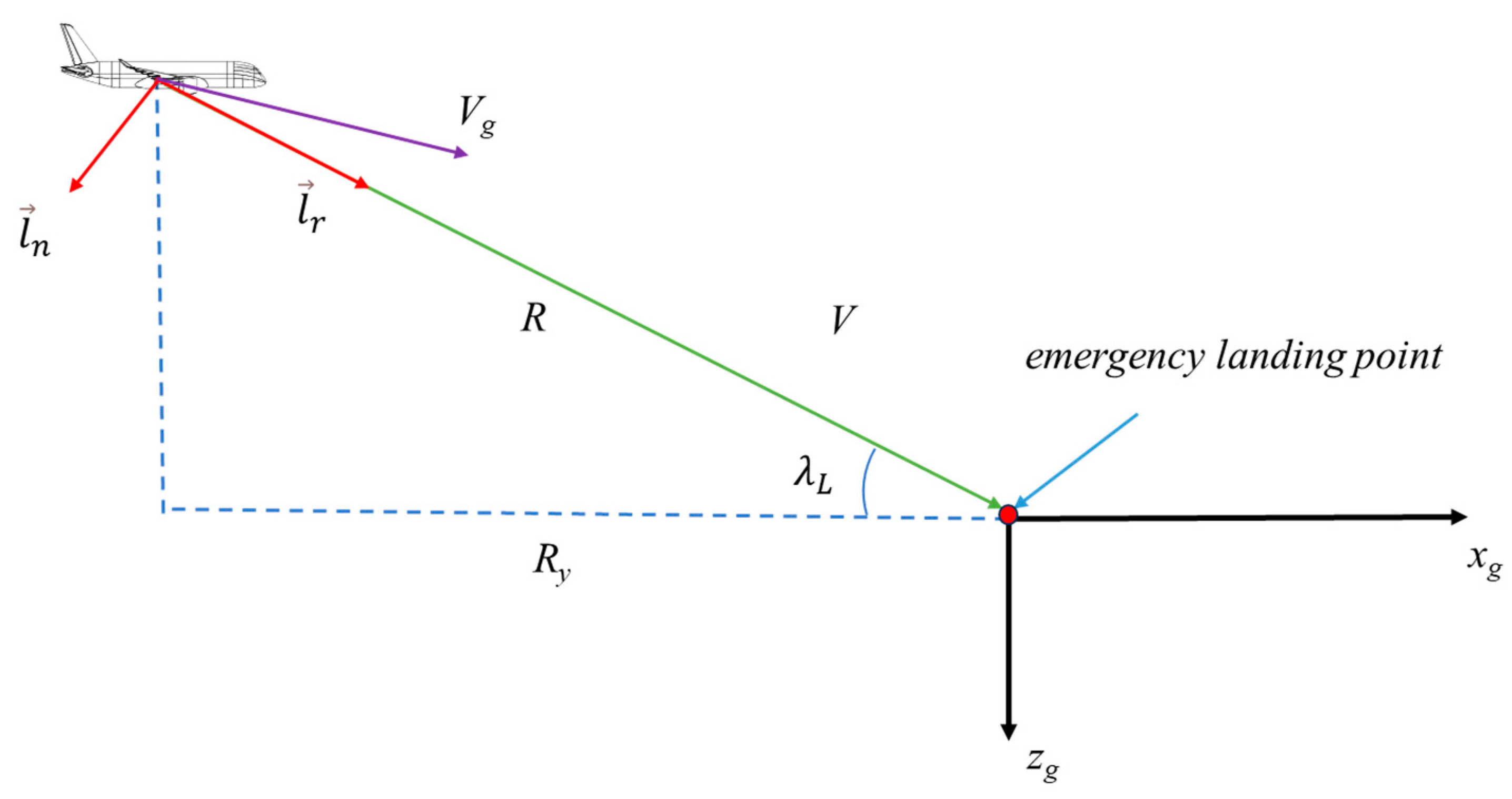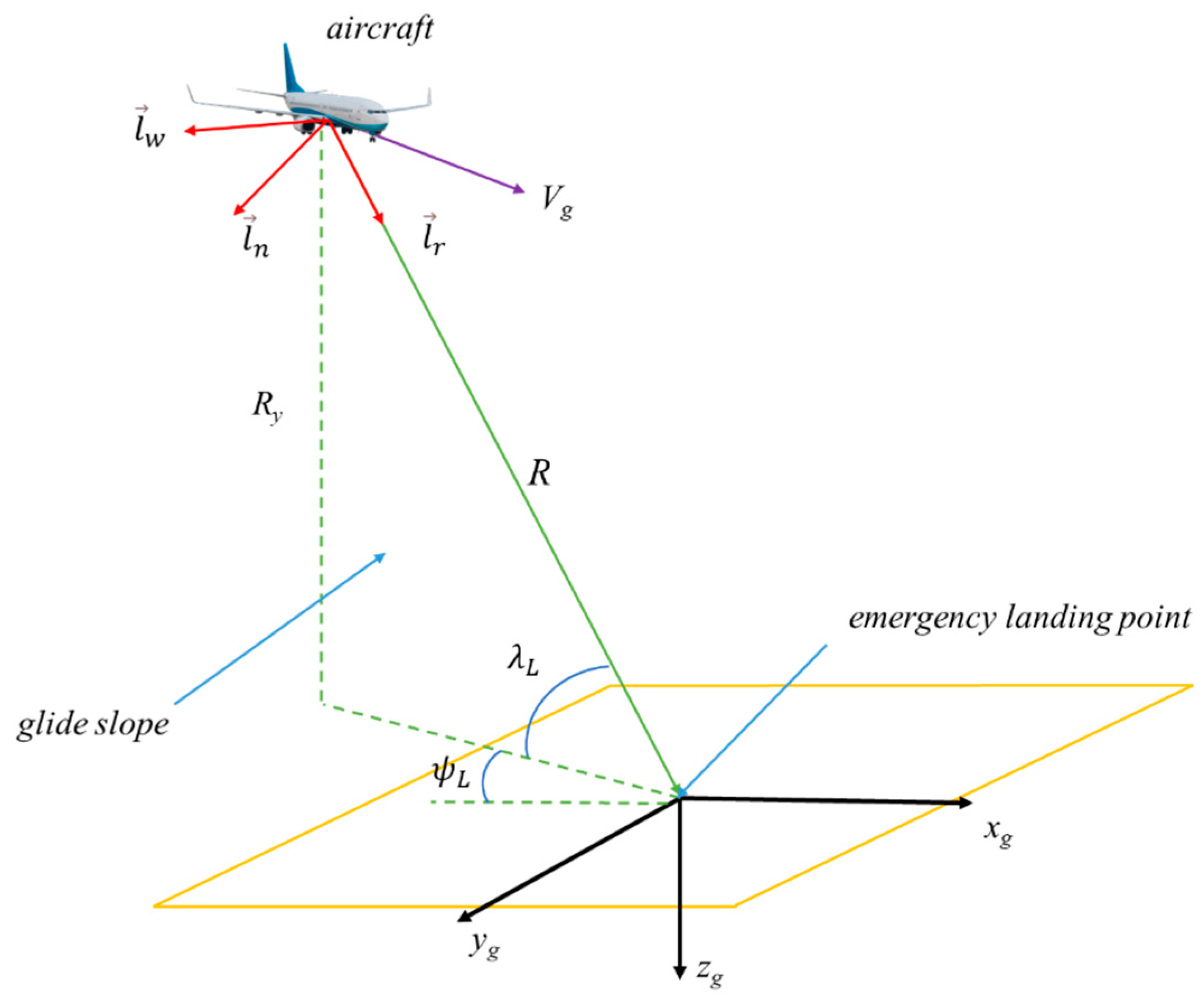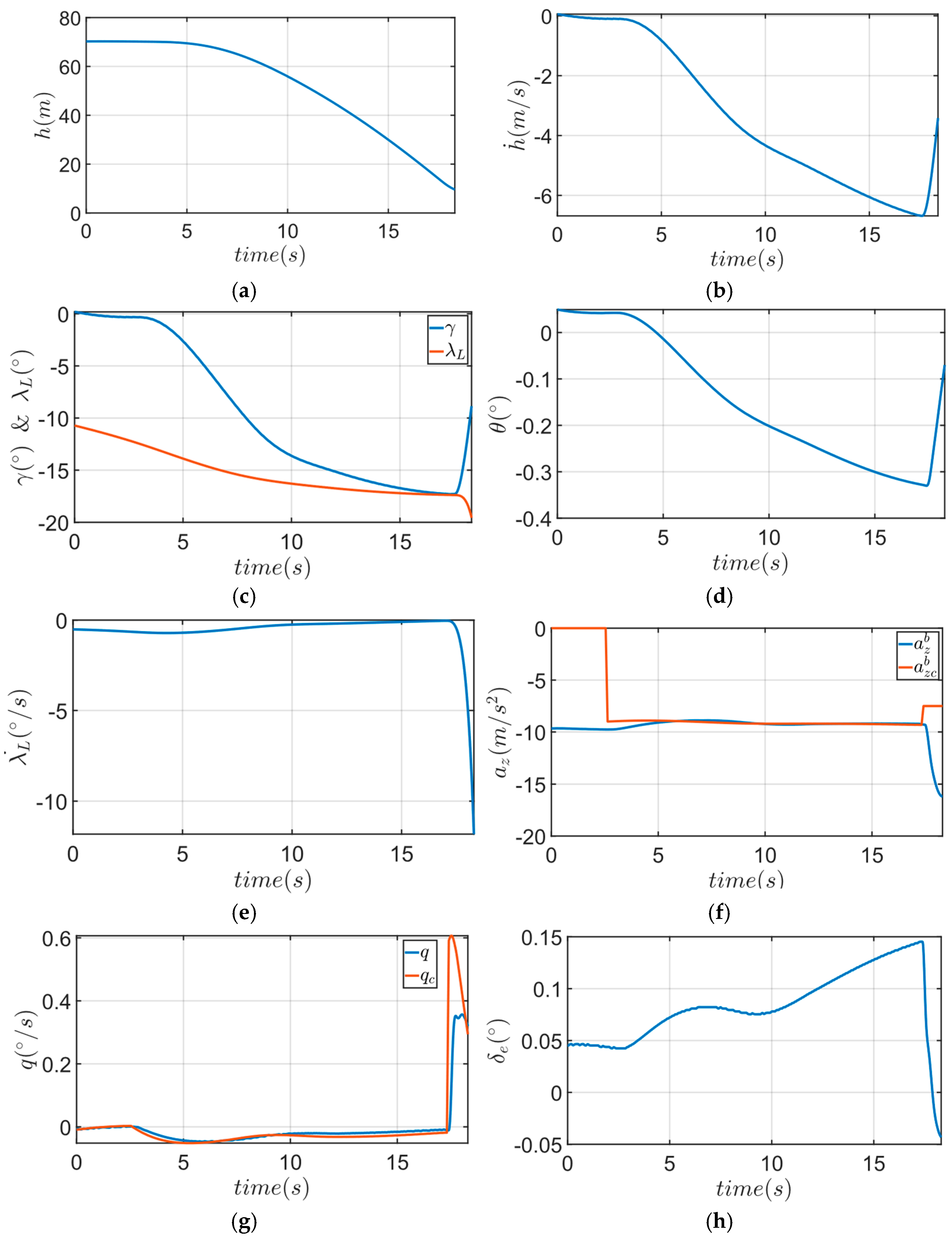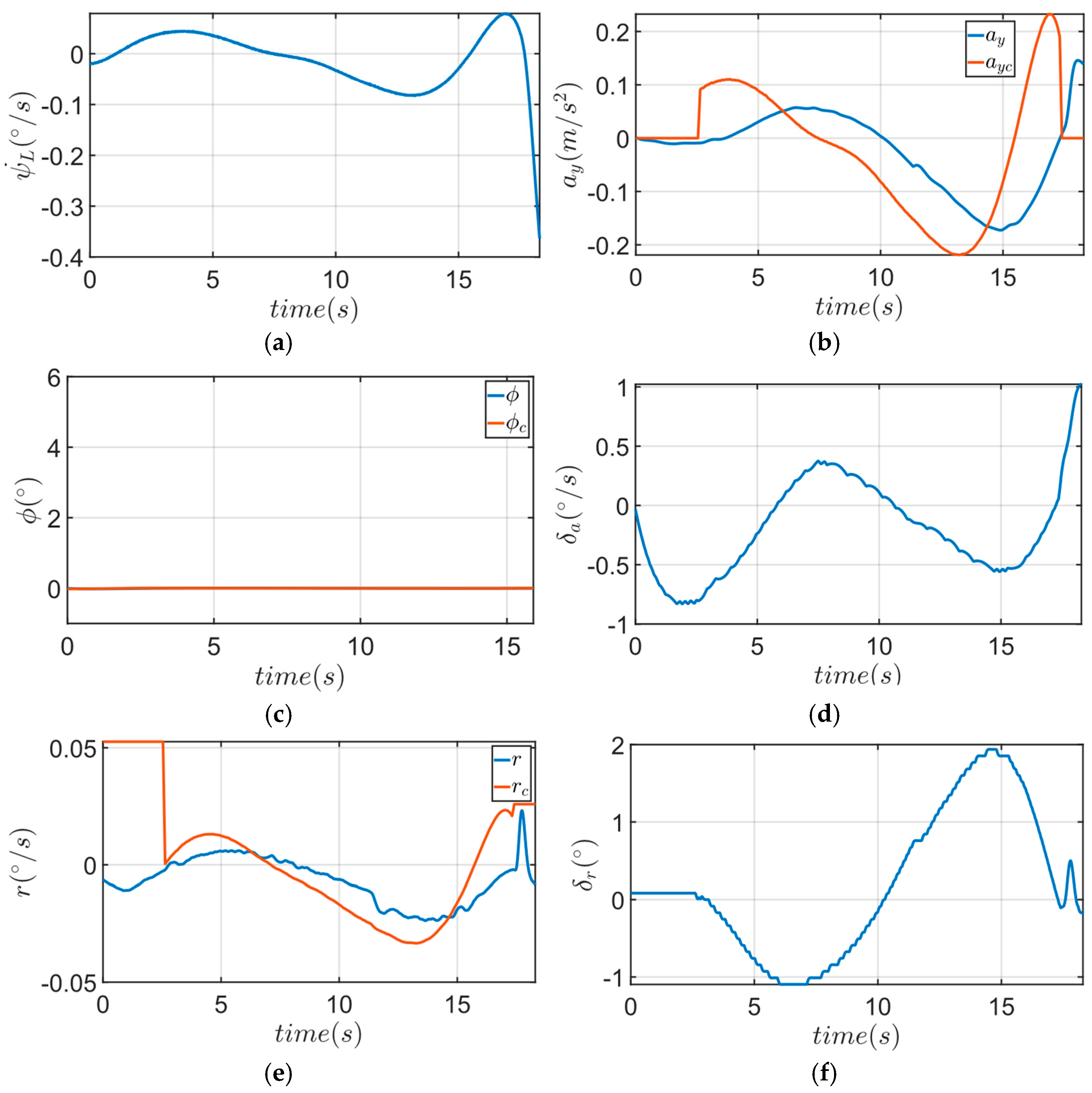Forced Landing Flight Test of Compound-Wing UAVs Based on Proportional Guidance
Abstract
1. Introduction
2. Development of Emergency Landing Guidance Strategies
2.1. Development of 2D Proportional Navigation Algorithm
2.2. Design of 3D Proportional Guidance Law
3. Control Law
3.1. Outer Loop
- Roll channel;
- 2.
- Pitch channel;
- 3.
- Yaw channel;
3.2. Inner Loop
4. Hardware-in-the-Loop Simulation
4.1. Hardware-in-the-Loop Simulation Architecture
4.2. Hardware-in-the-Loop Simulation Data Analysis
5. Flight Test Validation
5.1. Flight Test Mission
5.2. Flight Test Data Analysis
6. Conclusions
Author Contributions
Funding
Data Availability Statement
Conflicts of Interest
References
- Coombes, M.; Chen, W.-H.; Render, P. Reachability Analysis of Landing Sites for Forced Landing of a UAS in Wind using Trochoidal Turn Paths. In Proceedings of the 2015 International Conference on Unmanned Aircraft Systems (ICUAS), Denver, CO, USA, 9–12 June 2015. [Google Scholar]
- Coombes, M.; Chen, W.-H.; Render, P. Landing Site Reachability in a Forced Landing of Unmanned Aircraft in Wind. J. Aircr. 2017, 54, 1219–1234. [Google Scholar] [CrossRef]
- Fitzgerald, D.; Walker, R.; Campbell, D. A Vision Based Emergency Forced Landing System for an Autonomous UAV. In Proceedings of the Eleventh Australian International Aerospace Congress, Melbourne, Australia, 17 March 2005. [Google Scholar]
- Izuta, S.; Takahashi, M. Path Planning to Improve Reachability in a Forced Landing. J. Intell. Robot. Syst. 2017, 86, 291–307. [Google Scholar] [CrossRef]
- Fang, X.; Jiang, J.; Chen, W.H. Model Predictive Control With Wind Preview for Aircraft Forced Landing. IEEE Trans. Aerosp. Electron. Syst. 2023, 59, 3995–4004. [Google Scholar] [CrossRef]
- Chen, Y.; Wang, J.; Wang, C.; Shan, J.; Xin, M. A modified cooperative proportional navigation guidance law. J. Frankl. Inst. 2019, 356, 5692–5705. [Google Scholar] [CrossRef]
- Shin, H.S.; Li, K.B. An Improvement in Three-Dimensional Pure Proportional Navigation Guidance. IEEE Trans. Aerosp. Electron. Syst. 2021, 57, 3004–3014. [Google Scholar] [CrossRef]
- Ghosh, S.; Ghose, D.; Raha, S. Capturability of Augmented Pure Proportional Navigation Guidance Against Time-Varying Target Maneuvers. J. Guid. Control Dyn. 2014, 37, 1446–1458. [Google Scholar] [CrossRef]
- Jeon, I.-S.; Lee, J.-I.; Tahk, M.-J. Impact-Time-Control Guidance with Generalized Proportional Navigation Based on Nonlinear Formulation. J. Guid. Control Dyn. 2016, 39, 1885–1890. [Google Scholar] [CrossRef]
- Ghose, D. On the Generalization of True Proportional Navigation. IEEE Trans. Aerosp. Electron. Syst. 1994, 30, 545–555. [Google Scholar] [CrossRef]
- Prasanna, H.M.; Ghose, D. Retro-Proportional-Navigation: A New Guidance Law for Interception of High-Speed Targets. J. Guid. Control Dyn. 2012, 35, 377–386. [Google Scholar] [CrossRef]
- Ulybyshev, Y. Terminal Guidance Law Based on Proportional Navigation. J. Guid. Control Dyn. 2005, 28, 821–882. [Google Scholar] [CrossRef]
- Weiss, H.; Rusnak, I.; Hexner, G. Adaptive Proportional Navigation Guidance. In Proceedings of the 58th Israel Annual Conference, Aviv & Haifa, Israel, 14–15 March 2018. [Google Scholar]
- Adler, F.P. Missile Guidance by Three-Dimensional Proportional Navigation. J. Appl. Phys. 1956, 27, 500–507. [Google Scholar] [CrossRef]
- Becker, K. Closed-Form Solution of Pure Proportional Navigation. IEEE Trans. Aerosp. Electron. Syst. 1990, 26, 526–533. [Google Scholar] [CrossRef]
- Yang, C.D.; Yang, C.C. Optimal Pure Proportional Navigation for Maneuvering Targets. IEEE Trans. Aerosp. Electron. Syst. 1997, 33, 949–957. [Google Scholar] [CrossRef]
- Yuan, P.J.; Chern, J.S. Solutions of True Proportional Navigation for Maneuvering and Nonmaneuvering Targets. J. Guid. Control Dyn. 1992, 15, 268–271. [Google Scholar] [CrossRef]
- Yang, C.D.; Yang, C.C. Analytical Solution of 3D True Proportional Navigation. IEEE Trans. Aerosp. Electron. Syst. 1996, 32, 1509–1522. [Google Scholar] [CrossRef]
- Yang, C.D.; Yang, C.C. A Unified Approach to Proportional Navigation. IEEE Trans. Aerosp. Electron. Syst. 1997, 33, 557–567. [Google Scholar] [CrossRef]
- Ratnoo, A. Analysis of Two-Stage Proportional Navigation with Heading Constraints. J. Guid. Control Dyn. 2016, 39, 156–164. [Google Scholar] [CrossRef]
- Guelman, M. The Closed-Form Solution of True Proportional Navigation. IEEE Trans. Aerosp. Electron. Syst. 1976, 12, 472–482. [Google Scholar] [CrossRef]
- Guo, B.Z.; Zhao, Z. On the convergence of an extended state observer for nonlinear systems with uncertainty. Syst. Control Lett. 2011, 60, 420–430. [Google Scholar] [CrossRef]
- Eng, P. Path planning, guidance and control for a UAV forced landing. Doctoral dissertation, Queensland University of Technology, Brisbane, Queensland, Australia, 2011. [Google Scholar]















Disclaimer/Publisher’s Note: The statements, opinions and data contained in all publications are solely those of the individual author(s) and contributor(s) and not of MDPI and/or the editor(s). MDPI and/or the editor(s) disclaim responsibility for any injury to people or property resulting from any ideas, methods, instructions or products referred to in the content. |
© 2024 by the authors. Licensee MDPI, Basel, Switzerland. This article is an open access article distributed under the terms and conditions of the Creative Commons Attribution (CC BY) license (https://creativecommons.org/licenses/by/4.0/).
Share and Cite
Zhou, Z.; Yang, Y.; Gong, Z. Forced Landing Flight Test of Compound-Wing UAVs Based on Proportional Guidance. Actuators 2024, 13, 523. https://doi.org/10.3390/act13120523
Zhou Z, Yang Y, Gong Z. Forced Landing Flight Test of Compound-Wing UAVs Based on Proportional Guidance. Actuators. 2024; 13(12):523. https://doi.org/10.3390/act13120523
Chicago/Turabian StyleZhou, Zan, Yi Yang, and Zheng Gong. 2024. "Forced Landing Flight Test of Compound-Wing UAVs Based on Proportional Guidance" Actuators 13, no. 12: 523. https://doi.org/10.3390/act13120523
APA StyleZhou, Z., Yang, Y., & Gong, Z. (2024). Forced Landing Flight Test of Compound-Wing UAVs Based on Proportional Guidance. Actuators, 13(12), 523. https://doi.org/10.3390/act13120523




